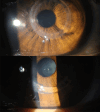One-Year Results of a Posterior Chamber Toric Phakic Intraocular Lens Implantation in Patients with Keratoconus
- PMID: 39372225
- PMCID: PMC11456293
- DOI: 10.2147/OPTH.S472606
One-Year Results of a Posterior Chamber Toric Phakic Intraocular Lens Implantation in Patients with Keratoconus
Abstract
Purpose: To determine clinical and refractive results after the implantation of EyeCryl Phakic Toric intraocular lens in patients with stable keratoconus.
Methods: The study included all patients diagnosed with keratoconus who underwent implantation of an EyeCryl Phakic Toric intraocular lens (Biotech Healthcare Holding; Ahmedabad, India) in at least one eye and had a follow-up of at least 12 months. Visual and refractive data were collected for all patients, along with corneal tomography measurements using Pentacam, and vault measurement using optical coherence tomography. This retrospective study was conducted at a high-volume private refractive surgery center in Medellín, Colombia.
Results: A total of 83 eyes from 47 patients were included in the study. The majority (71.1%) were female, with a mean age of 31.2 ± 5.1 years. After 12 months of follow-up post-surgery, the spherical equivalent improved significantly from -8.19 ± 4.04 D to -0.06 ± 0.48 D (p < 0.001). Furthermore, 77% of eyes had a post-surgical spherical equivalent within ±0.50 D, while 92% had residual astigmatism ≤0.50 D. Twelve months after surgery, mean manifest astigmatism was -0.28 ± 0.27 D. Uncorrected visual acuity also showed improvement, from 1.11 ± 0.35 LogMAR to 0.14 ± 0.11 LogMAR. Moreover, 52.4% of eyes demonstrated an improvement of at least one line in best-corrected visual acuity. Notably, no intraoperative or postoperative complications were observed in the study population.
Conclusion: The implantation of EyeCryl Phakic Toric intraocular lenses represents a highly effective and safe option for correcting refractive errors in patients with a history of keratoconus. Refractive accuracy is excellent, and a significant proportion of patients experienced an improvement in their best-corrected vision by at least one line.
Keywords: intraocular; keratoconus; lens implantation; refractive error.
© 2024 Balparda et al.
Conflict of interest statement
The lead author (K.B.) is a paid consultant and speaker for Biotech Healthcare and participates in educational and training programs for other surgeons on the use of the brand’s products. However, Biotech Healthcare had no role, influence, or involvement in the design, data collection, statistical analysis, or writing of this article. They also had no role in the decision to conduct or publish the study and did not have access to any individual patient databases. The author received no compensation for conducting this study. The other co-authors have no conflicts of interest to declare.
Figures



Similar articles
-
Phakic intraocular lenses for the treatment of refractive errors: an evidence-based analysis.Ont Health Technol Assess Ser. 2009;9(14):1-120. Epub 2009 Oct 1. Ont Health Technol Assess Ser. 2009. PMID: 23074518 Free PMC article.
-
Early results with the EyeCryl Phakic Toric intraocular lens implantation in keratoconus patients.Rom J Ophthalmol. 2021 Apr-Jun;65(2):163-170. doi: 10.22336/rjo.2021.32. Rom J Ophthalmol. 2021. PMID: 34179582 Free PMC article.
-
Three-year follow-up of posterior chamber toric phakic intraocular lens implantation for the correction of high myopic astigmatism in eyes with keratoconus.Br J Ophthalmol. 2015 Feb;99(2):177-83. doi: 10.1136/bjophthalmol-2014-305612. Epub 2014 Aug 21. Br J Ophthalmol. 2015. PMID: 25147365
-
Toric intraocular lens versus limbal relaxing incisions for corneal astigmatism after phacoemulsification.Cochrane Database Syst Rev. 2019 Dec 17;12(12):CD012801. doi: 10.1002/14651858.CD012801.pub2. Cochrane Database Syst Rev. 2019. PMID: 31845757 Free PMC article.
-
Phakic intraocular Lens implantation in keratoconus patients.Eur J Ophthalmol. 2024 Sep;34(5):1365-1372. doi: 10.1177/11206721231199780. Epub 2023 Sep 3. Eur J Ophthalmol. 2024. PMID: 37661651 Review.
References
-
- Fard AM, Patel SP, Nader ND. The efficacy of 2 different phakic intraocular lens implant in keratoconus as an isolated procedure or combined with collagen crosslinking and intra-stromal corneal ring segments: a systematic review and meta-analysis. Int Ophthalmol. 2023;43(11):4383–4393. doi:10.1007/s10792-023-02813-z - DOI - PubMed
-
- Balparda K, Silva-Quintero LA, Herrera-Chalarca T. Unilateral toxic anterior segment syndrome after immediate sequential bilateral phakic intraocular lens implantation. JCRS Online Case Rep. 2022;10(2):e00072. doi:10.1097/j.jcro.0000000000000072 - DOI
LinkOut - more resources
Full Text Sources

